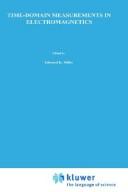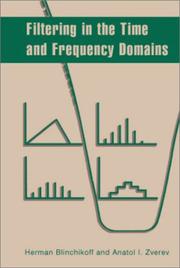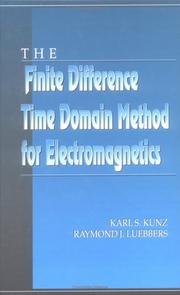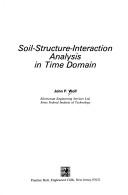| Listing 1 - 10 of 138 | << page >> |
Sort by
|
Book
Year: 1994 Publisher: [Lieu de publication inconnu]: U.S. Department of interior. Bureau of mines,
Abstract | Keywords | Export | Availability | Bookmark
 Loading...
Loading...Choose an application
- Reference Manager
- EndNote
- RefWorks (Direct export to RefWorks)

ISBN: 0442263848 Year: 1986 Publisher: New York (N.Y.) : Van Nostrand Reinhold,
Abstract | Keywords | Export | Availability | Bookmark
 Loading...
Loading...Choose an application
- Reference Manager
- EndNote
- RefWorks (Direct export to RefWorks)
Book
ISBN: 1608071774 9781608071777 9781608071760 1608071766 Year: 2011 Publisher: Boston : [Piscataqay, New Jersey] : Artech House, IEEE Xplore,
Abstract | Keywords | Export | Availability | Bookmark
 Loading...
Loading...Choose an application
- Reference Manager
- EndNote
- RefWorks (Direct export to RefWorks)
The finite-difference time-domain (FDTD) method has revolutionized antenna design and electromagnetics engineering. Here's a cutting-edge book that focuses on the performance optimization and engineering applications of FDTD simulation systems. Covering the latest developments in this area, this unique resource offer you expert advice on the FDTD method, hardware platforms, and network systems. Moreover the book offers guidance in distinguishing between the many different electromagnetics software packages on the market today. You also find a complete chapter dedicated to large multi-scale problem solving. This practical reference is supported with 250 illustrations, 128 equations, and 11 appendixes filled with helpful data processing techniques related to the FDTD method.
Book
Year: 2019 Publisher: Golden, CO : National Renewable Energy Laboratory,
Abstract | Keywords | Export | Availability | Bookmark
 Loading...
Loading...Choose an application
- Reference Manager
- EndNote
- RefWorks (Direct export to RefWorks)

ISBN: 1884932177 Year: 2001 Publisher: Atlanta Noble
Abstract | Keywords | Export | Availability | Bookmark
 Loading...
Loading...Choose an application
- Reference Manager
- EndNote
- RefWorks (Direct export to RefWorks)

ISBN: 0849386578 9780849386572 Year: 1993 Publisher: Boca Raton (Fla.): CRC,
Abstract | Keywords | Export | Availability | Bookmark
 Loading...
Loading...Choose an application
- Reference Manager
- EndNote
- RefWorks (Direct export to RefWorks)
Electromagnetic fields --- -Time-domain analysis --- Mathematics --- Time-domain analysis. --- Mathematics. --- Electromagnetic fields - - Mathematics --- Time-domain analysis

ISBN: 0138229740 9780138229740 Year: 1988 Publisher: Englewood Cliffs : Prentice-Hall International,
Abstract | Keywords | Export | Availability | Bookmark
 Loading...
Loading...Choose an application
- Reference Manager
- EndNote
- RefWorks (Direct export to RefWorks)
Soil dynamics. --- Structural dynamics. --- Time-domain analysis.
Book
ISBN: 9781119071822 9781118860144 Year: 2015 Publisher: Hoboken, New Jersey [Piscataqay, New Jersey] John Wiley & Sons Inc. IEEE Xplore
Abstract | Keywords | Export | Availability | Bookmark
 Loading...
Loading...Choose an application
- Reference Manager
- EndNote
- RefWorks (Direct export to RefWorks)
Introduces timed arrays and design approaches to meet the new high performance standards The author concentrates on any aspect of an antenna array that must be viewed from a time perspective. The first chapters briefly introduce antenna arrays and explain the difference between phased and timed arrays. Since timed arrays are designed for realistic time-varying signals and scenarios, the book also reviews wideband signals, baseband and passband RF signals, polarization and signal bandwidth. Other topics covered include time domain, mutual coupling, wideband elements, and dispersion. The author also presents a number of analog and digital beamforming networks for creating and manipulating beams. The book concludes with an overview of the methods to integrate time delay into the array design and of several other adaptive arrays that prove useful in many different systems. . Examines RF signal concepts such as polarization and signal bandwidth and their applications to timed antenna arrays. Covers arrays of point source, elements in timed antenna arrays, active electronically scanned array technology, and time delay in corporate fed arrays. Includes complete design examples for placing time delay in arrays Timed Arrays: Wideband and Time Varying Antenna Arrays is written for practicing engineers and scientists in wireless communication, radar, and remote sensing as well as graduate students and professors interested in advanced antenna topics. Randy Haupt, PhD., is Professor and Department Head of EECS at the Colorado School of Mines. He received his PhD from the University of Michigan and retired from the USAF as a LtCol. Dr. Haupt was an RF staff consultant at Ball Aerospace & Technologies, Corp., senior scientist and department head at the Applied Research Laboratory of Penn State, professor and department head of ECE at Utah State, professor and chair of EE at the University of Nevada Reno, and professor of EE at the USAF Academy. Dr. Haupt is a Fellow of the IEEE and Applied Computational Electromagnetics Society (ACES).
Antenna arrays. --- Adaptive antennas. --- Time-domain analysis.
Book
ISBN: 1504402367 Year: 1966 Publisher: Piscataway, NJ : IEEE,
Abstract | Keywords | Export | Availability | Bookmark
 Loading...
Loading...Choose an application
- Reference Manager
- EndNote
- RefWorks (Direct export to RefWorks)
This document is a companion to Technical Committee Report on Recommended Practices for Burst Measurements in the Time Domain, IEEE No. 257, May 1964. In the time domain document, bursts are defined and particular attention is placed on their duration and magnitude.The use of additional characteristics may prove desirable when investigating both cause and effect of a burst. Mathematical transformations have been widely used to bring out particular characteristics of signals. Perhaps the one most commonly used is the Fourier Transform, which defines the spectrum of signals. The energy density spectrum of a burst, a quantity derived from the Fourier Transform, is the subject of this report. Other transformations such as those of Hilbert or Hankel, may be used to display different characteristics of a burst but they will not be considered here. Sampling the energy density spectrum is the key concept of this document. It constitutes the basis by which this spectrum can be characterized comprehensively by a practical number of measurements. The sampling theorems in the frequency domain are, therefore, given detailed consideration in Appendices to the extent necessary for understanding the measurement methods to be discussed.
Book
Year: 1965 Publisher: Reading (Mass.) : Addison-Wesley,
Abstract | Keywords | Export | Availability | Bookmark
 Loading...
Loading...Choose an application
- Reference Manager
- EndNote
- RefWorks (Direct export to RefWorks)
System analysis. --- Control theory. --- Time-domain analysis.
| Listing 1 - 10 of 138 | << page >> |
Sort by
|

 Search
Search Feedback
Feedback About UniCat
About UniCat  Help
Help News
News